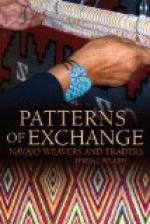The reddish dye is made of the bark of Alnus incana var. virescens (Watson) and the bark of the root of Cercocarpus parvifolius; the mordant being fine juniper ashes. On buckskin this makes a brilliant tan-color; but applied to wool it produces a much paler tint.
Sec. III. Plate XXXVIII and Fig. 42 illustrate ordinary blanket-looms. Two posts, a a, are set firmly in the ground; to these are lashed two cross-pieces or braces, b c, the whole forming the frame of the loom. Sometimes two slender trees, growing at a convenient distance from one another, are made to answer for the posts, d is a horizontal pole, which I call the supplementary yarn-beam, attached to the upper brace, b, by means of a rope, e e, spirally applied. f is the upper beam of the loom. As it is analogous to the yarn-beam of our looms, I will call it by this name, although once only have I seen the warp wound around it. It lies parallel to the pole d, about 2 or 3 inches below it, and is attached to the latter by a number of loops, g g. A spiral cord wound around the yarn-beam holds the upper border cord h h, which, in turn, secures the upper end of the warp i i. The lower beam of the loom is shown at k. I will call this the cloth-beam, although the finished web is never wound around it; it is tied firmly to the lower brace, c, of the frame, and to it is secured the lower border cord of the blanket. The original distance between the two beams is the length of the blanket. Lying between the threads of the warp is depicted a broad, thin, oaken stick, l, which I will call the batten. A set of healds attached to a heald-rod, m, are shown above the batten. These healds are made of cord or yarn; they include alternate threads of the warp, and serve when drawn forward to open the lower shed. The upper shed is kept patent by a stout rod, n (having no healds attached), which I name the shed-rod. Their substitute for the reed of our looms is a wooden fork, which will be designated as the reed-fork (Fig. 44, a).
[Illustration: FIG. 42.—Ordinary Navajo blanket loom.]
For convenience of description, I am obliged to use the word “shuttle,” although, strictly speaking, the Navajo has no shuttle. If the figure to be woven is a long stripe, or one where the weft must be passed through 6 inches or more of the shed at one time, the yarn is wound on a slender twig or splinter, or shoved through on the end of such a piece of wood; but where the pattern is intricate, and the weft passes at each turn through only a few inches of the shed, the yarn is wound into small skeins or balls and shoved through with the finger.




